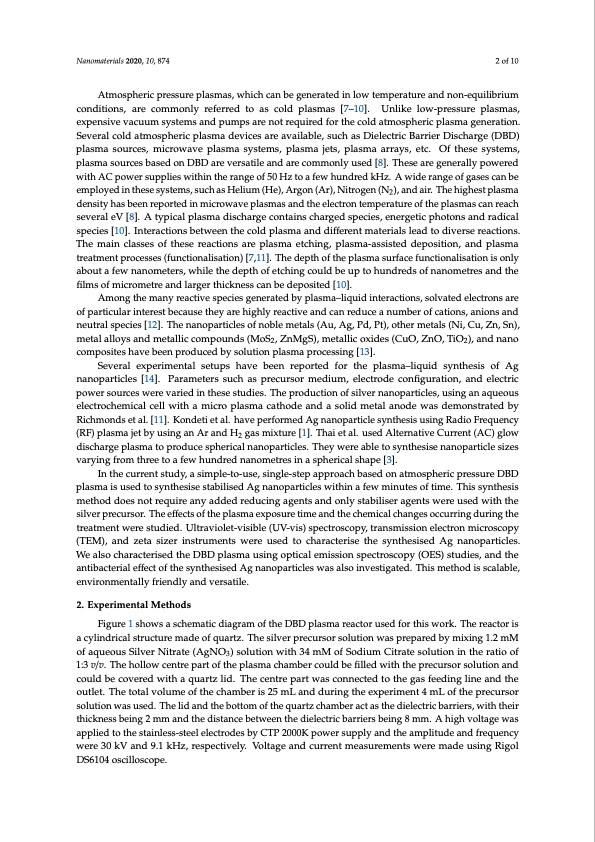
PDF Publication Title:
Text from PDF Page: 002
Nanomaterials 2020, 10, 874 2 of 10 Atmospheric pressure plasmas, which can be generated in low temperature and non-equilibrium conditions, are commonly referred to as cold plasmas [7–10]. Unlike low-pressure plasmas, expensive vacuum systems and pumps are not required for the cold atmospheric plasma generation. Several cold atmospheric plasma devices are available, such as Dielectric Barrier Discharge (DBD) plasma sources, microwave plasma systems, plasma jets, plasma arrays, etc. Of these systems, plasma sources based on DBD are versatile and are commonly used [8]. These are generally powered with AC power supplies within the range of 50 Hz to a few hundred kHz. A wide range of gases can be employed in these systems, such as Helium (He), Argon (Ar), Nitrogen (N2), and air. The highest plasma density has been reported in microwave plasmas and the electron temperature of the plasmas can reach several eV [8]. A typical plasma discharge contains charged species, energetic photons and radical species [10]. Interactions between the cold plasma and different materials lead to diverse reactions. The main classes of these reactions are plasma etching, plasma-assisted deposition, and plasma treatment processes (functionalisation) [7,11]. The depth of the plasma surface functionalisation is only about a few nanometers, while the depth of etching could be up to hundreds of nanometres and the films of micrometre and larger thickness can be deposited [10]. Among the many reactive species generated by plasma–liquid interactions, solvated electrons are of particular interest because they are highly reactive and can reduce a number of cations, anions and neutral species [12]. The nanoparticles of noble metals (Au, Ag, Pd, Pt), other metals (Ni, Cu, Zn, Sn), metal alloys and metallic compounds (MoS2, ZnMgS), metallic oxides (CuO, ZnO, TiO2), and nano composites have been produced by solution plasma processing [13]. Several experimental setups have been reported for the plasma–liquid synthesis of Ag nanoparticles [14]. Parameters such as precursor medium, electrode configuration, and electric power sources were varied in these studies. The production of silver nanoparticles, using an aqueous electrochemical cell with a micro plasma cathode and a solid metal anode was demonstrated by Richmonds et al. [11]. Kondeti et al. have performed Ag nanoparticle synthesis using Radio Frequency (RF) plasma jet by using an Ar and H2 gas mixture [1]. Thai et al. used Alternative Current (AC) glow discharge plasma to produce spherical nanoparticles. They were able to synthesise nanoparticle sizes varying from three to a few hundred nanometres in a spherical shape [3]. In the current study, a simple-to-use, single-step approach based on atmospheric pressure DBD plasma is used to synthesise stabilised Ag nanoparticles within a few minutes of time. This synthesis method does not require any added reducing agents and only stabiliser agents were used with the silver precursor. The effects of the plasma exposure time and the chemical changes occurring during the treatment were studied. Ultraviolet-visible (UV-vis) spectroscopy, transmission electron microscopy (TEM), and zeta sizer instruments were used to characterise the synthesised Ag nanoparticles. We also characterised the DBD plasma using optical emission spectroscopy (OES) studies, and the antibacterial effect of the synthesised Ag nanoparticles was also investigated. This method is scalable, environmentally friendly and versatile. 2. Experimental Methods Figure 1 shows a schematic diagram of the DBD plasma reactor used for this work. The reactor is a cylindrical structure made of quartz. The silver precursor solution was prepared by mixing 1.2 mM of aqueous Silver Nitrate (AgNO3) solution with 34 mM of Sodium Citrate solution in the ratio of 1:3 v/v. The hollow centre part of the plasma chamber could be filled with the precursor solution and could be covered with a quartz lid. The centre part was connected to the gas feeding line and the outlet. The total volume of the chamber is 25 mL and during the experiment 4 mL of the precursor solution was used. The lid and the bottom of the quartz chamber act as the dielectric barriers, with their thickness being 2 mm and the distance between the dielectric barriers being 8 mm. A high voltage was applied to the stainless-steel electrodes by CTP 2000K power supply and the amplitude and frequency were 30 kV and 9.1 kHz, respectively. Voltage and current measurements were made using Rigol DS6104 oscilloscope.PDF Image | Bactericidal Silver Nanoparticles by Plasma Processing

PDF Search Title:
Bactericidal Silver Nanoparticles by Plasma ProcessingOriginal File Name Searched:
nanomaterials-10-00874.pdfDIY PDF Search: Google It | Yahoo | Bing
Turbine and System Plans CAD CAM: Special for this month, any plans are $10,000 for complete Cad/Cam blueprints. License is for one build. Try before you buy a production license. More Info
Waste Heat Power Technology: Organic Rankine Cycle uses waste heat to make electricity, shaft horsepower and cooling. More Info
All Turbine and System Products: Infinity Turbine ORD systems, turbine generator sets, build plans and more to use your waste heat from 30C to 100C. More Info
CO2 Phase Change Demonstrator: CO2 goes supercritical at 30 C. This is a experimental platform which you can use to demonstrate phase change with low heat. Includes integration area for small CO2 turbine, static generator, and more. This can also be used for a GTL Gas to Liquids experimental platform. More Info
Introducing the Infinity Turbine Products Infinity Turbine develops and builds systems for making power from waste heat. It also is working on innovative strategies for storing, making, and deploying energy. More Info
Need Strategy? Use our Consulting and analyst services Infinity Turbine LLC is pleased to announce its consulting and analyst services. We have worked in the renewable energy industry as a researcher, developing sales and markets, along with may inventions and innovations. More Info
Made in USA with Global Energy Millennial Web Engine These pages were made with the Global Energy Web PDF Engine using Filemaker (Claris) software.
Infinity Turbine Developing Spinning Disc Reactor SDR or Spinning Disc Reactors reduce processing time for liquid production of Silver Nanoparticles.
| CONTACT TEL: 608-238-6001 Email: greg@infinityturbine.com | RSS | AMP |